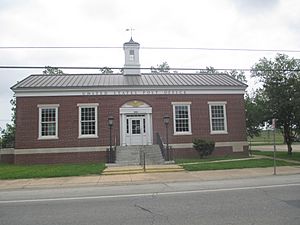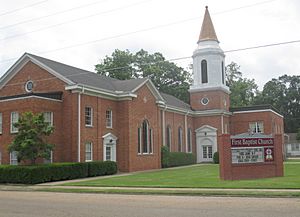Lake Providence, Louisiana facts for kids
Quick facts for kids
Lake Providence, Louisiana
|
|
|---|---|
|
Town
|
|

Louisiana State Cotton Museum in 2013
|
|
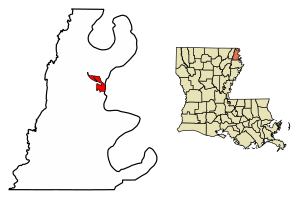
Location of Lake Providence in East Carroll Parish, Louisiana.
|
|

Location of Louisiana in the United States
|
|
| Country | United States |
| State | Louisiana |
| Parish | East Carroll |
| Area | |
| • Total | 3.62 sq mi (9.36 km2) |
| • Land | 3.60 sq mi (9.31 km2) |
| • Water | 0.02 sq mi (0.05 km2) |
| Elevation | 105 ft (32 m) |
| Population
(2020)
|
|
| • Total | 3,587 |
| • Density | 997.77/sq mi (385.28/km2) |
| Time zone | UTC-6 (CST) |
| • Summer (DST) | UTC-5 (CDT) |
| ZIP Code |
71254
|
| Area code(s) | 318 |
| FIPS code | 22-41400 |
| Website | Town of Lake Providence |
Lake Providence is a town in northeastern Louisiana. It is the main town, or parish seat, of East Carroll Parish. In 2020, about 3,587 people lived there.
The town is named after a special lake called an oxbow lake. This lake was once part of the Mississippi River. Before the Civil War, this area had many large cotton farms. During the Civil War, the Union Army set up a supply base near the lake. Many enslaved people came to this camp seeking freedom. This is how the town of Lake Providence grew.
Contents
History of Lake Providence
In the late 1700s, people used longboats to move goods like animal furs and cotton on the Mississippi River. Later, steamboats took over. Thieves and pirates would sometimes attack these longboats.
One pirate named Bunch would raid boats at a tricky bend in the river. If boatmen made it past this dangerous spot without being robbed, they would say they "made it to Providence."
A trading town called Providence grew at this bend. It was later renamed Lake Providence. The town moved to its current spot around the natural oxbow lake. This area was opened for European-American settlers in the late 1830s. This happened after the government moved Native American tribes further west. Settlers then cleared the land for farming, often using enslaved African Americans.
The Civil War Years
By 1861, when the American Civil War began, this region had many large cotton farms. Thousands of slave laborers worked on these farms.
The town of Lake Providence really started to grow after the Union Army arrived in the spring of 1862. General Ulysses S. Grant chose the area by Lake Providence as a place to store supplies. It also served as a base for the Vicksburg Campaign. Soldiers dug a canal between the Mississippi River and Lake Providence. They called the area "Soldiers' Rest."
As the war continued, many enslaved people from nearby farms came to the camp at Lake Providence. They were seeking their freedom. The population quickly grew from a few hundred people to several thousand. What started as a small military camp became a busy town filled with African-American refugees.
By 1863, when Vicksburg, Mississippi was captured by the Union, most farm owners in the Lake Providence area had left. Their farms were empty. The Union Army decided these farms should be used again.
Lake Providence in the 20th Century
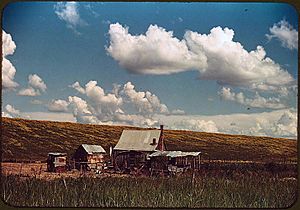
After the Civil War, white leaders in Louisiana tried to regain control. Many Black people worked as sharecroppers or tenant farmers. In 1898, Louisiana created new laws that made it very hard for Black people to vote. This meant they were treated as second-class citizens, even though the 15th Amendment gave them the right to vote.
The civil rights movement in the mid-1900s worked to make sure everyone had equal rights. For forty years, no African Americans were allowed to register to vote in Lake Providence. But in 1962, a judge named Edwin Ford Hunter, Jr. personally registered twenty-eight African Americans to vote. This was done under a new law called the Civil Rights Act of 1960.
This event gained national attention. It showed how important the civil rights movement was. After the 1960s, many African Americans supported the Democratic Party. Today, most voters in Lake Providence still support Democratic candidates.
Geography and Climate
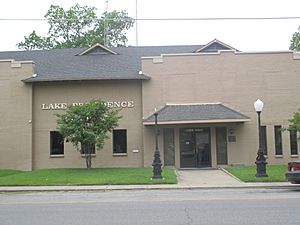
Lake Providence covers about 3.6 square miles (9.3 square kilometers). Most of this area is land, with a small part being water.
The town has moved three times because of the Mississippi River. Before levees were built, the river would flood and wash away land. This flooding created the oxbow lake that the town is named after. Each time the river flooded the town, the people moved to a new spot.
Historian John D. Winters described Lake Providence as "a beautiful oxbow lake." It is about six miles (10 km) long. It was once an old part of the Mississippi River. The lake connects to other rivers through Baxter Bayou.
Local Climate
| Climate data for Lake Providence, Louisiana (1991–2020 normals, extremes 1893–1903, 1926–2019) | |||||||||||||
|---|---|---|---|---|---|---|---|---|---|---|---|---|---|
| Month | Jan | Feb | Mar | Apr | May | Jun | Jul | Aug | Sep | Oct | Nov | Dec | Year |
| Record high °F (°C) | 86 (30) |
89 (32) |
93 (34) |
95 (35) |
99 (37) |
108 (42) |
109 (43) |
109 (43) |
110 (43) |
98 (37) |
98 (37) |
88 (31) |
110 (43) |
| Mean daily maximum °F (°C) | 53.7 (12.1) |
58.2 (14.6) |
66.4 (19.1) |
74.4 (23.6) |
81.9 (27.7) |
88.4 (31.3) |
91.2 (32.9) |
91.1 (32.8) |
86.8 (30.4) |
77.1 (25.1) |
65.2 (18.4) |
56.3 (13.5) |
74.2 (23.4) |
| Daily mean °F (°C) | 44.8 (7.1) |
48.6 (9.2) |
56.2 (13.4) |
64.2 (17.9) |
72.6 (22.6) |
79.5 (26.4) |
82.3 (27.9) |
81.8 (27.7) |
76.7 (24.8) |
66.1 (18.9) |
54.7 (12.6) |
47.3 (8.5) |
64.6 (18.1) |
| Mean daily minimum °F (°C) | 35.8 (2.1) |
39.0 (3.9) |
45.9 (7.7) |
54.0 (12.2) |
63.4 (17.4) |
70.6 (21.4) |
73.4 (23.0) |
72.5 (22.5) |
66.5 (19.2) |
55.0 (12.8) |
44.3 (6.8) |
38.4 (3.6) |
54.9 (12.7) |
| Record low °F (°C) | −5 (−21) |
−8 (−22) |
16 (−9) |
32 (0) |
40 (4) |
50 (10) |
41 (5) |
55 (13) |
35 (2) |
29 (−2) |
18 (−8) |
3 (−16) |
−8 (−22) |
| Average precipitation inches (mm) | 5.61 (142) |
5.49 (139) |
5.16 (131) |
6.59 (167) |
4.98 (126) |
4.26 (108) |
3.93 (100) |
4.03 (102) |
3.29 (84) |
4.99 (127) |
4.72 (120) |
5.74 (146) |
58.79 (1,493) |
| Average snowfall inches (cm) | 0.2 (0.51) |
0.2 (0.51) |
trace | 0.0 (0.0) |
0.0 (0.0) |
0.0 (0.0) |
0.0 (0.0) |
0.0 (0.0) |
0.0 (0.0) |
0.0 (0.0) |
0.0 (0.0) |
0.1 (0.25) |
0.5 (1.3) |
| Average precipitation days (≥ 0.01 in) | 9.6 | 9.0 | 9.2 | 8.0 | 8.6 | 8.2 | 8.1 | 7.5 | 5.5 | 6.5 | 8.4 | 10.1 | 98.7 |
| Average snowy days (≥ 0.1 in) | 0.1 | 0.2 | 0.1 | 0.0 | 0.0 | 0.0 | 0.0 | 0.0 | 0.0 | 0.0 | 0.0 | 0.0 | 0.4 |
| Source: NOAA | |||||||||||||
Population Data
| Historical population | |||
|---|---|---|---|
| Census | Pop. | %± | |
| 1860 | 582 | — | |
| 1870 | 320 | −45.0% | |
| 1890 | 642 | — | |
| 1900 | 1,256 | 95.6% | |
| 1910 | 1,568 | 24.8% | |
| 1920 | 1,917 | 22.3% | |
| 1930 | 2,867 | 49.6% | |
| 1940 | 3,711 | 29.4% | |
| 1950 | 4,123 | 11.1% | |
| 1960 | 5,781 | 40.2% | |
| 1970 | 6,183 | 7.0% | |
| 1980 | 6,361 | 2.9% | |
| 1990 | 5,380 | −15.4% | |
| 2000 | 5,104 | −5.1% | |
| 2010 | 3,991 | −21.8% | |
| 2020 | 3,587 | −10.1% | |
| U.S. Decennial Census | |||
Here's a look at the different groups of people living in Lake Providence in 2020:
| Race | Num. | Perc. |
|---|---|---|
| White (non-Hispanic) | 597 | 16.64% |
| Black or African American (non-Hispanic) | 2,883 | 80.37% |
| Asian | 4 | 0.11% |
| Other/Mixed | 73 | 2.04% |
| Hispanic or Latino | 30 | 0.84% |
In 2020, there were 3,587 people living in Lake Providence. They lived in 1,221 households, with 695 of these being families.
Schools in Lake Providence
The public schools in Lake Providence are run by the East Carroll Parish School Board. They include:
- Southside Elementary School (for grades Pre-Kindergarten to 5th grade)
- Lake Providence Junior High School (for grades 6th to 8th grade)
- Lake Providence Senior High School (for grades 9th to 12th grade)
There is also a private school called Briarfield Academy for students from Pre-Kindergarten to 12th grade.
Lake Providence in TV Shows
Some episodes of the 1959 NBC television series Riverboat feature pirates on the Mississippi River. They also show the shipping of cotton. The show is set in the mid-1800s.
Famous People from Lake Providence
- Clifford Cleveland Brooks: A farmer who represented East Carroll Parish in the state senate from 1924 to 1932.
- William Denis Brown, III: A lawyer and businessman who grew up near Lake Providence. He was a state senator.
- Vail M. Delony: A state representative from East Carroll Parish from 1940 to 1967. He was also the Speaker of the Louisiana House.
- Leonard Griffin: An NFL football player.
- John Martin Hamley: A state representative and later a parish tax assessor.
- William J. Jefferson: A former U.S. representative from Louisiana.
- Joseph Kerr: A U.S. Senator who moved to Lake Providence. His son, Joseph Kerr Jr., was born here and died at the Battle of the Alamo.
- Francis Xavier Ransdell: A judge in the Louisiana 6th Judicial District from 1900 to 1936.
- Joseph E. Ransdell: A lawyer and farmer from Lake Providence. He was a U.S. Representative and a three-term U.S. Senator.
- John Henry Scott: Born in Lake Providence, he worked to help African Americans gain voting and civil rights in Louisiana.
- Vivien Theodore Thomas: An American laboratory supervisor. He helped create a surgery to treat "blue baby syndrome" in the 1940s. This surgery helped make Johns Hopkins a famous hospital for heart surgery. The movie Something the Lord Made is about his life.
- Aaron "Rudy" Threats: The longest-serving Chief of Police in Lake Providence's history.
- David Ransdell Voelker: Born in Lake Providence, he became a successful business owner and helper of good causes in New Orleans.
- Frank Voelker, Jr.: A city attorney for Lake Providence. He was also a candidate for governor in 1963.
- Frank Voelker Sr.: A lawyer and judge for the 6th Judicial District Court.
- Norris C. Williamson: A state senator from the Delta parishes from 1916 to 1932.
- Edith Wilmans: The first woman elected to the Texas State Legislature.
- John D. Winters: A historian who studied the Civil War.
- Captan Jack Wyly: A politician and lawyer from Lake Providence.
- Charles and Sam Wyly: Billionaire brothers who started several companies. The Tower of Learning at Louisiana Tech University is named after Charles Wyly.
See also
 In Spanish: Lake Providence para niños
In Spanish: Lake Providence para niños



